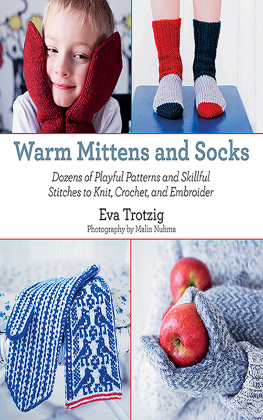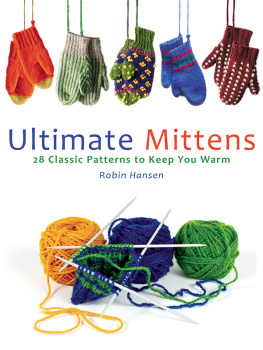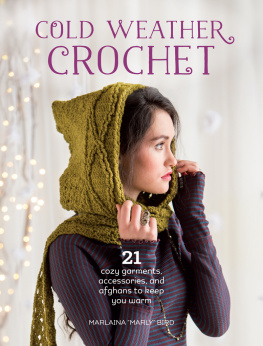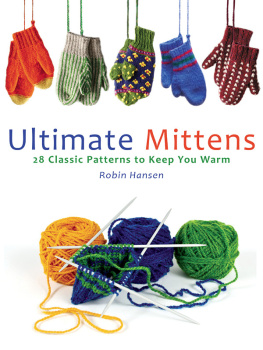Warm Mittens and Socks
Dozens of Playful Patterns and
Skillful Stitches to Knit, Crochet,
and Embroider

Eva Trotzig
Photography by Malin Nuhma
Translated by Ellen Hedstrm

S KYHORSE P UBLISHING

Copyright 2012 by Eva Trotzig
English Translation 2013 by Skyhorse Publishing
First published in 2012 as Varma tumvantar och ngra sockor by Eva Trotzig, Bokfrlaget Semic, Sundbyberg, Sweden
Photography by Malin Nuhma
Facts examined by Erika Atkins
Diagrams by sa Martinsson, Martinsson, and Eriksson HB, Visby. The diagrams are made in WeavePoint. Design by Monica Sundberg
All Rights Reserved. No part of this book may be reproduced in any manner without the express written consent of the publisher, except in the case of brief excerpts in critical reviews or articles. All inquiries should be addressed to
Skyhorse Publishing, 307 West 36th Street, 11th Floor, New York, NY 10018.
Skyhorse Publishing books may be purchased in bulk at special discounts for sales promotion, corporate gifts, fund-raising, or educational purposes. Special editions can also be created to specifications. For details, contact the Special Sales Department, Skyhorse Publishing, 307 West 36th Street, 11th Floor, New York, NY 10018 or info@skyhorsepublishing.com.
Skyhorse and Skyhorse Publishing are registered trademarks of Skyhorse Publishing, Inc., a Delaware corporation.
www.skyhorsepublishing.com
10 9 8 7 6 5 4 3 2 1
Library of Congress Cataloging-in-Publication Data is available on file.
ISBN: 978-1-62873-566-6
Printed in China
Contents
Introduction
Why are we still knitting by hand when the first knitting machine was built as early as the sixteenth century? The answer is simple: because its fun. When we knit by hand we create something original; the results are never the sameeven when two people knit according to the same pattern. Apart from the joy of knitting socks and mittens, its a convenient project to take with you when youre on the road, having a coffee, or watching television. A knitting project doesnt take up much room and you dont need very much material.
For this book, my friends and I knitted socks and mittens that mean something to us, and in doing so, I have been allowed to experience fantastic patterns that I would never have thought to create myself. Were driven to share the different ways of creating and knitting that we have learned throughout our lives and that we are passionate about.
Who are these friends then? Where do you find womenand menwho are 5 prepared to share their patterns? Apart from myself, there were seventeen people who took part in this book and they all work with textiles. Some are amateurs and some are professionals, but they are united by the fact that they love to create. Here you will find knitted, crocheted, sewn, knotlessly knitted, and woven items, and of course, these socks and mittens and everything in between reflect our times and cultures, as well as the opportunities and limitations that surround us. A lot of love and care are woven into these warm clothes. Many of the mittens are made with yarn that has been crafted from Swedish wool and spun in Sweden, where I live and have my roots. stergtlands Woolen Mill shows us that it is possible to produce beautiful and functional wool on a large scale, and at Herrviks and Grimsltts farms, the sheep lead a good life and quality yarns are produced on a smaller scale. These are perfect for knitting. As you can see, warm mittens can be locally producedwhen it comes to knitting them, as well as when making the wool.
Handmade socks and mittens can also be a response to our need to reuse that which we already have. Worn out sweaters can be felted and sewn into mittens, and scraps of yarn can be used to make socks and mittens that are warm, felted, and functional.
This book is for those who know the basics of knitting and crocheting, but those who are not well versed in handicrafts can find good resources in a book shop or library. Many of the steps can also be learned on the Internet, and YouTube is a real goldmine.
I dont think its too bold to state that you can find mittens for everyone here. These patterns all continue old traditions and create new ones. So be inspired to create using our ideas and your own. My hope in writing this book is that you will use the colors you and your friends love, play with the patterns, and have fun.

Traditions
Traditional mittens can be amazing creations. Mittens from the Baltic countriesoften made with very thin knitting needles and several colorscan be works of art. The thin yarn, thin needles, and the skill of the knitter all result in something exquisite. Traditions live on and books with patterns are published. Even when its hard to get hold of beautiful, thin yarn made from wool, patterns and styles live on with the help of synthetic yarns. These arent able to give the same warmth, but the knowledge is kept alive. At the end of this book (page 92) is an excellent example of how a pair of fingerless mittens from Estonia have been recreated in Sweden.
Even in my country of Sweden, traditions are very much alive and are being passed on to new generations. In different regions of Sweden, different patterns and styles are kept alive. Gotland (an island off the coast of Sweden) has a treasure trove of mittens that are made with two colors. On land (another coastal island) they develop their own patterns, and in northern Sweden there are colorful mittens with yellow, red, and blue that are reminiscent of the Sami culture. Two-end knitting and Nalbinding (or knotless knitting) are traditions that we hope will always survive. Sometimes it happens that the same pattern appears in different places, and a mitten from Estonia and one from Sweden can have the same pattern without any connection.
Sweden doesnt only have its own traditions and creations. In todays society, handicrafts are enhanced by the fact that many Swedes have their roots in different countries and some of them come with their own traditions. In the world of weaving, I have seen women who came to Sweden as adults learn weaving techniques alongside other studies. Handicrafts create bonds between people, and the lack of a common language is not a hindrance. I personally had the fortune to meet many women through knitting many years ago, and it was a very giving experience, both craft-wise and socially.
Traditions are passed on in different ways. We like to have romantic notions about the old ways. By candlelight and maybe with a fire burning in the grate, an old grandma and a little girl sit by the hearth. The old teaches the young how to knit and a little ditty is repeated again and again, insert the needle, bring the yarn over, slip the stitch off, and the little girl eventually learns. May-be this is how it was taught before, but society has changed quite a bit since then. Its no longer the grandma who teaches knitting; it can just as easily be a father or even YouTube. Playfulness and ideas have no limitsone trend is graffiti knitting, whereby you cover bicycles and park benches in knit-work, or young people who knit covers for their cell phones and laptops. As you can see, we are constantly searching for new ideas for our work, and I hope this book can give both new ideas and established techniques. The search for the ultimate mitten or glove continues and maybe you will be the one to knit it.












